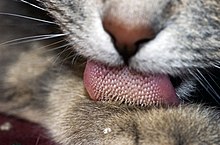Health
Main article: Cat health
The average life expectancy for male indoor cats at birth is around 12 to 14 years, with females usually living a year or two longer. However, there have been reports of cats reaching into their 30s, with the oldest known cat, Creme Puff, dying at a verified age of 38. Feline life expectancy has increased significantly in recent decades. Having a cat neutered or spayedconfers some health benefits, since castrated males cannot develop testicular cancer, spayed females cannot develop uterine or ovarian cancer, and both have a reduced risk of mammary cancer. The lifespan of feral cats is hard to determine accurately, although one study reported a median age of 4.7 years, with a range between 0 to 8.3 years.
Diseases
Cats can suffer from a wide range of health problems, including infectious diseases, parasites, injuries and chronic disease. Vaccinations are available for many of these diseases, and domestic cats are regularly given treatments to eliminate parasites such as worms and fleas.
Poisoning
In addition to obvious dangers such as rodenticides, insecticides and herbicides, cats may be poisoned by many chemicals that are usually considered safe by pet owners. This is because their livers are less effective at some forms of detoxification than those of many other animals, including humans and dogs. Some of the most common causes of poisoning in cats are antifreeze and rodent baits. It has also been suggested that cats may be particularly sensitive to environmental pollutants. When a cat has a sudden or prolonged serious illness without any obvious cause, it is possible that it has been exposed to a toxin.
Human medicines should never be given to cats. For example, the painkiller paracetamol (also called acetaminophen, sold as Tylenol and Panadol) is extremely toxic to cats: even very small doses need immediate treatment and can be fatal. Even aspirin, which is sometimes used to treat arthritis in cats, is much more toxic to them than to humans and must be administered cautiously Similarly, application of minoxidil (Rogaine) to the skin of cats, either accidentally or by well-meaning owners attempting to counter loss of fur, has sometimes been fatal. Essential oils can be toxic to cats and there have been reported cases of serious illnesses caused by tea tree oil, including flea treatments and shampoos containing it.
Other common household substances that should be used with caution around cats include mothballs and other naphthalene products. Phenol-based products (e.g. Pine-Sol, Dettol (Lysol) orhexachlorophene) are often used for cleaning and disinfecting near cats' feeding areas or litter boxes but these can sometimes be fatal. Ethylene glycol, often used as an automotiveantifreeze, is particularly appealing to cats, and as little as a teaspoonful can be fatal. Some human foods are toxic to cats for example chocolate can cause theobromine poisoning, although (unlike dogs) few cats will eat chocolate. Large amounts of onions or garlic are also poisonous to cats. Many houseplants are also dangerous, such as Philodendron species and the leaves of the Easter lily (Lilium longiflorum), which can cause permanent and life-threatening kidney damage.







